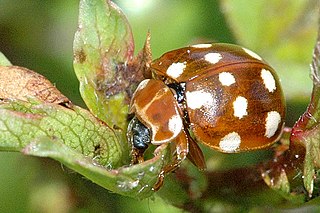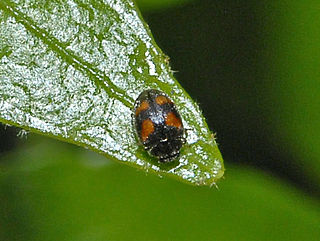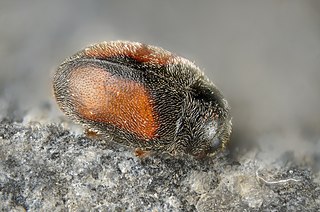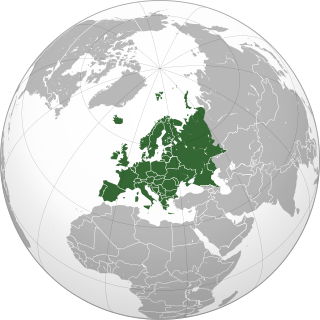
Harmonia axyridis, most commonly known as the harlequin, multicolored Asian, or simply Asian ladybeetle, is a large coccinellid beetle. This is one of the most variable species in the world, with an exceptionally wide range of color forms. It is native to eastern Asia, but has been artificially introduced to North America and Europe to control aphids and scale insects. It is now common, well known, and spreading in those regions, and has also established in Africa and widely across South America. This species is conspicuous in North America where it may locally be known as the Halloween ladybeetle. It earns this name as it often invades homes during October, in order to prepare for overwintering.

Ladybird Books is a London-based publishing company, trading as a stand-alone imprint within the Penguin Group of companies. The Ladybird imprint publishes mass-market children's books.

Eresus sandaliatus is a species of spider found primarily in northern and central Europe. Like other species of the genus Eresus, it is commonly called ladybird spider because of the coloration of the male.

Coccinella septempunctata, the seven-spot ladybird, is the most common ladybird in Europe. Its elytra are of a red colour, but punctuated with three black spots each, with one further spot being spread over the junction of the two, making a total of seven spots, from which the species derives both its common and scientific names.

The long-eared chipmunk, also called the Sacramento chipmunk or the four-banded chipmunk, is a species of rodent in the squirrel family, Sciuridae. It is endemic to the central and northern Sierra Nevada of California and Nevada in the United States. Long-eared chipmunks have the longest ears of all species of chipmunks.

Dromius quadrimaculatus is a species of ground beetle native to the Palearctic and the Near East. In Europe, it is found in Austria, Belarus, Belgium, Bosnia and Herzegovina, Bulgaria, Corsica, the Czech Republic, mainland Denmark, Estonia, Finland, mainland France, Germany, Great Britain including the Isle of Man, mainland Greece, Hungary, the Republic of Ireland, mainland Italy, Kaliningrad, Latvia, Liechtenstein, Lithuania, Luxembourg, Malta, Moldova, Northern Ireland, North Macedonia, mainland Norway, Poland, Russia, Sardinia (doubtful), Slovakia, Slovenia, mainland Spain, Sweden, Switzerland, the Netherlands, Ukraine, and Yugoslavia.

The cream-spot ladybird, Calvia quatuordecimguttata, is a species of ladybird in the family Coccinellidae. Its distribution is holarctic, it being found in Europe and through the East Palearctic to Japan. It is introduced to North America. This ladybird is generally 4 to 5 millimetres in length and varies in appearance depending on the geographical location. It usually lives in hedgerows and deciduous trees.

Nephus is a genus of lady beetles in the family Coccinellidae. There are more than 25 described species in Nephus. Several former species are now in the genus Scymnobius.

Palaeocimbex quadrimaculatus is a species of sawflies in the family Cimbicidae, the only species in the genus Palaeocimbex.

Nephus redtenbacheri is a species of beetle in family Coccinellidae. It is found in the Palearctic (Europe, North Africa, European Russia, Ciscaucasia, Siberia, the Russian Far East, Belarus, Ukraine, Moldova and Western Asia.
Nephus ornatus, the ornate lady beetle, is a species of dusky lady beetle in the family Coccinellidae. It is found in North America.
Nephus georgei, known generally as the George's lady beetle or Farmer's lady beetle, is a species of dusky lady beetle in the family Coccinellidae. It is found in North America.
Scymnobius sordidus, known generally as the little brown mealybug destroyer or sordid ladybug, is a species of dusky lady beetle in the family Coccinellidae. It is found in North America.
Scymnobius atramentarius is a species of dusky lady beetle in the family Coccinellidae. It is found in North America.
Nephus binaevatus is a species of dusky lady beetle in the family Coccinellidae. It is found in Africa, North America, and Oceania.
Pycnoderes quadrimaculatus, the bean capsid, is a species of plant bug in the family Miridae. It is found in the Caribbean, Central America, North America, Oceania, and South America.
Scymnobius flavifrons, the yellow-fronted lady beetle, is a species of dusky lady beetle in the family Coccinellidae. It is found in North America.
Scymnobius quadrarius is a species of dusky lady beetle in the family Coccinellidae. It is found in North America.














